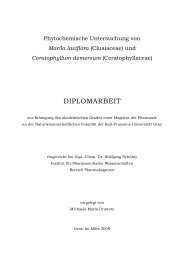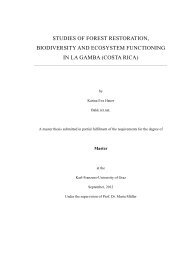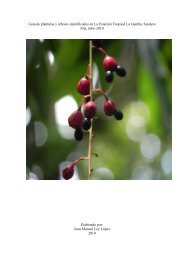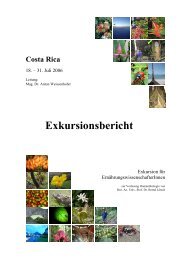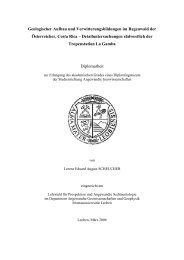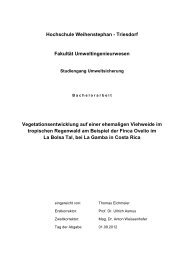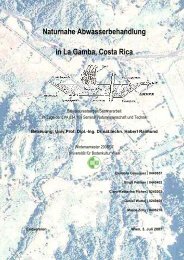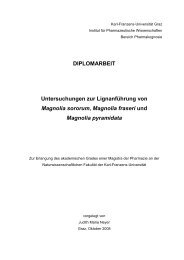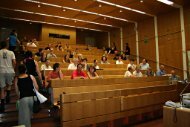Leaf colour patterns, vegetative and sexual reproduction of Episcia ...
Leaf colour patterns, vegetative and sexual reproduction of Episcia ...
Leaf colour patterns, vegetative and sexual reproduction of Episcia ...
Create successful ePaper yourself
Turn your PDF publications into a flip-book with our unique Google optimized e-Paper software.
Pro<strong>of</strong> <strong>of</strong> Anthocyanins <strong>and</strong> Analysis <strong>of</strong> the Colouring Agents with the UV/VIS-Spectrometry<br />
Anthocyanins are secondary metabolites <strong>and</strong> are part <strong>of</strong> the large phenolic family collectively<br />
known as the flavonoids. The anthocyanin molecule consists <strong>of</strong> an anthocyanidin (the aglycone<br />
chromophore), tied to one or more glycosides (Paech 1950). The maximum absorption <strong>of</strong><br />
anthocyanins lies between 500 to 550 nm (Harborne 1967).<br />
Anthocyanins have the ability to change their <strong>colour</strong> in correspondence with changes <strong>of</strong> the<br />
pH-value. The experiments described below were conducted to prove that anthocyanins are<br />
responsible for the leaf <strong>colour</strong>ation <strong>of</strong> <strong>Episcia</strong> lilacina as well as to check if there are anthocyanins<br />
even in the bright green leaves.<br />
Materials <strong>and</strong> Methods: To be sure that anthocyanins are responsible for the red<br />
<strong>colour</strong>ation, the pH-value has been increased from low to high. Leaves <strong>of</strong> the red morphs were<br />
cut <strong>and</strong> anthocyanins were extracted with aqua. Hydrochloric acid (0,01mol/l) was added until<br />
the pH-value reached the level <strong>of</strong> 2. Afterwards, Ammonium hydroxide (50 per cent) was added<br />
until a pH-value <strong>of</strong> 9 was obtained. By comparison, the same experiment was performed with the<br />
leaves <strong>of</strong> African violet (Saintpaulia ionantha).<br />
To demonstrate a difference in the content <strong>of</strong> anthocyanins between the green <strong>and</strong> the redmorphs<br />
<strong>of</strong> <strong>Episcia</strong> lilacina, the UV/VIS-spectrometry was used. 15 plants were taken from Costa<br />
Rica to Austria to accomplish experiments, which were not possible in the laboratory <strong>of</strong> the Field<br />
Station La Gamba. In Austria the plants were kept in a greenhouse <strong>of</strong> the Botanical Garden <strong>of</strong><br />
the University <strong>of</strong> Vienna. The following method was modified after Strigl et al (1995).<br />
To receive the clearest possible results, the two most extreme leaf-morphs were chosen.<br />
From the green leaves 2,15 g were weighed, from the red ones 1,14 g. The leaves were cut <strong>and</strong><br />
grinded in a mortar with about 10 ml <strong>of</strong> 70% methanol <strong>and</strong> sea s<strong>and</strong>. The solid parts were<br />
separated through a filter. From the supernatant the methanol was distilled on the rotary<br />
evaporator. The solution was shaken out twice with benzine to separate the covalent parts <strong>and</strong><br />
then with ethyl acetate to extract the flavonoids <strong>and</strong> other phenolic compounds. To eliminate the<br />
ethyl acetate the rotary evaporator was used. One more time the solution was filtered (0,2µm).<br />
The measurement <strong>of</strong> the extinction took place in the UV/VIS spectrometer with a wavelength <strong>of</strong><br />
522 nm. The absorption maximum <strong>of</strong> 522 nm was determined in a previous measurement.<br />
Results: At low pH-values a change in <strong>colour</strong> to red in the solutions could be observed with<br />
<strong>Episcia</strong> lilacina as well as with Saintpaulia ionantha. After addition <strong>of</strong> base, the <strong>colour</strong> <strong>of</strong> both<br />
solutions changed to brownish.<br />
30



